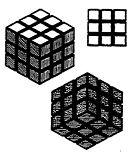3D trademark: a brainteaser
- NewsletterThe validity of 3D trademarks, where signs are composed of the shape of products, is tending to turn into an enigma as complex as the Rubik’s Cube itself.
The European Court of Justice has precisely focused, by a decision dated November 10, 2016, on the validity of the trademark composed of the well-known three dimensions puzzle:

A competitor had sued for cancellation of this trademark, on the ground that the shape of the sign is necessary to obtain a technical result. He considered that the black ridges, giving form to a grid structure on surfaces of the cube, are indispensable to the rotating capability of the puzzle. This shape should therefore remain available for competitors unless to grant a monopoly on a technical solution to the owner of that mark.
By decision of November 25, 2014, the General Court of the European Union rejected this claim. In a nutshell, it held that the rotating capacity of the cube could not be inferred from the sign itself, but from the knowledge of an internal mechanism of the Rubik’s Cube allowing to shift the puzzle’s surfaces. Yet, the examination of the validity of the sign shall only encompass the graphic representation of the shape at stake, as it has been filed, but not the technical capabilities which can be deduced from such shape but which remain invisible as regards to the graphic representation.
The European Court of Justice set aside the General Court’s ruling, although consistent with the assessment process of signs’ validity. Not only the graphic representation of the sign, but also the technical function of the product itself shall be taken into account while assessing the 3D sign’ validity. In other words, the technical feature of the shape shall be assessed in view of the technical functions of the goods subject to that shape.
This decision weakens slightly over 3D trademarks, of which the scope of validity tends to restrict. Besides, it risks reopening the battles around the Rubik’s Cube’s trademarks, whose validity had always been recognized until now in France.
A breach in the unitary character of European trademarks
The Court of Justice of the European Union created a breach in the unitary character of European trademarks. As a reminder, according to this principle, European trademarks are given uniform protection and this protection must be effective throughout the entire area of the European Union.
The German owner of a European trademark designating goods and services in the IT sector requested a prohibition of the utilisation of the name used by a competitor for software, throughout the European Union territory.
The particularity of the case was based on linguistic reasons: indeed, there was a likelihood of confusion between both signs for German speakers, but not for English speakers. For the latter, the lack of conceptual similarities removed any phonetic and visual similarities.
The German Court submitted the case to the Court of Justice in order to assess whether when a likelihood of confusion exists in a specific part of the European Union, the counterfeit acts are established in all or part of the territory.
By decision rendered on 22 September 2016, the European judges replied that the infringement of the owner’s rights was established as soon as there was a likelihood of confusion, even in one part only of the European Union territory. However, the judges added that when there was no likelihood of confusion in some parts of the territory, the order prohibiting the use of the litigious sign should be limited to the territory where the risk exists.
It will be up to defendants to prove that for linguistic or other reasons, there is no likelihood of confusion in some member states. They may thus escape from a general prohibition order for all the European Union territory.